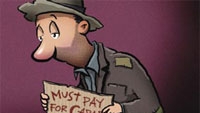FEEDBACK
Revisiting “Competition is ugly”
Dear editor:

I work in the cable business and take strong exception to your statement at the end of “Competition is ugly” in September 2007. You say “free enterprise doesn't apply to cable TV because for most viewers, there is no competition. Most would call that a monopoly. Cable just calls it business.”
I live in Dallas. The cable penetration rate here hovers between 30 percent and 40 percent. Are the remaining 60 percent to 70 percent of the people not watching television? I think they are, either with DISH Network, DIRECTV, AT&T U-verse, Verizon FiOS or an antenna. If the cable company has only one-third of the market, there is pretty effective competition here.
Leslie W. Read
Cable Television Technical Support
Editor responds:
In March, Multichannel News reported that the U.S. cable penetration dropped to a 17-year low of 61.3 percent. The Dallas-Fort Worth market was mentioned as one of the markets hardest hit, with 48.5 percent of TV households there paying for TV from an alternate delivery platform. However, that means that cable's penetration in Dallas-Fort Worth is 51.5 percent, not 30 to 40 percent as you suggested.
Part II
The professional video industry's #1 source for news, trends and product and tech information. Sign up below.
Dear editor:
I thoroughly enjoyed your article about cable competition and the à la carte issue in the September 2007 editorial. I somewhat agree with what Alex Nogales and Brian Dietz are saying. The satellite-delivered services to the cable companies are compensated on a per customer basis. Bundle this in with other more popular viewed satellite channels, and they stay afloat. By themselves — and I bet they have the marketing data to show this — their viewership would be small enough to put them out of business.
Check out the cable TV top 10 programs for this week on nielsenmedia.com. Most of them are sports programs. The cable viewing public has decided what it wants to watch, and I guess freedom of choice is discrimination.
Cable companies do not have a monopoly. There is plenty of competition from DBS, the Internet (podcasting, music videos, etc.), telcos and now your handy little cell phone, all of which have video and audio services galore.
As far as competition in a particular community for wired cable services is concerned, this has been tried without much success. In El Cajon, CA, two new cable companies opened up franchises in the 1980s, and it was a giant mess. Three times the underground construction caused homeowners to complain about having so many pedestals in their yards. There is only so much real estate on the poles for proper clearances. Cox had the majority, and it did lower its rates in El Cajon. Being the big guy on the block crushed it. A cable company needs so many customers per mile to make it, just like the minority satellite television provider.
Personally, I would like to see everything pay-per-view. Want to watch season one, episode nine of “M*A*S*H?” You could download it right now, watch it when you want and keep it on your hard drive for the future. With more than 30 years engineering experience in cable TV, telecommunications, broadcasting and now DBS, I can say this is where things are headed. Broadcasters should wise up and start marketing their products instead of continuing to sell time because that time no longer exists.
Daniel Farey?
Field Engineering
Echostar Satellite
Test Your Knowledge!
Do you know your phase? Subcarrier to horizontal phase (SCH) refers to the ______ relationship between the ______ edge of ______ sync (at the 50 percent amplitude point) and the zero crossings of the color burst. The error is expressed as SCH phase and is expressed in _____ of subcarrier phase. The question was taken from Keith Jack’s book, “Video Demystified,” Fifth Edition, available from Focal Press.
Send answers toeditor@broadcastengineering.com
